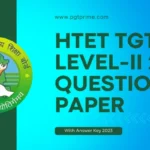👉FROM (Q.41-To-Q.60)
41. Ibn Battuta the famous traveller who authored Rihala, book of travels, was contemporary to which Sultan of Delhi :
- Iltutmish
- Alauddin Khalji
- Muhammad bin Tughlaq
- Firoz Shah Tughlaq
Answer: KVS LDCE History Question Paper and Answers PDF 2023
(3) Muhammad bin Tughlaq
Ibn Battuta visited the Delhi Sultanate in India. Ibn Battuta’s writings provide valuable insights into the socio-political, cultural, and historical aspects of the Delhi Sultanate during the reign of Muhammad bin Tughlaq.
42. Al-Beruni’s Kitab-ul Hind was written in which language :
- Persian
- Turkic
- Arabic
- Sanskrit
Answer: KVS LDCE History Question Paper and Answers PDF 2023
(3) Arabic
Al-Beruni’s Kitab-ul Hind (Book of India) was written in Arabic. Al-Beruni, an Islamic scholar and polymath, composed this significant work during the 11th century CE. In Kitab-ul Hind, Al-Beruni extensively documented various aspects of Indian culture, religion, philosophy, science, mathematics, geography, and more.
43. Who is credited to have given a unique form to the Chishti sama by introducing the Qaul – meaning a hymn sung at the opening and closing of Qawwali?
- Nizamuddin Auliya
- Qutbuddin Bhakhtiyar Kaki
- Hamid ud-din Nagauri
- Amir Khusrau
Answer: KVS LDCE History Question Paper and Answers PDF 2023
(4) Amir Khusrau
Amir Khusrau is credited with giving a unique form to the Chishti sama by introducing the Qaul. Amir Khusrau was a prominent Sufi poet, musician, and scholar who lived in the 13th century. He was a disciple of the famous Sufi saint Nizamuddin Auliya and played a significant role in the development of Qawwali, a devotional music form.
44. Khalisa land Was :
- Land under continous cultivation
- Revenue free land granted as rewards
- Land under the direct control of the state
- Fallow land
Answer: KVS LDCE History Question Paper and Answers PDF 2023
(3) Land under the direct control of the state
Khalisa land refers to land under the direct control of the state. The revenue from Khalisa land would directly go to the state treasury, and it was not subject to any revenue sharing or assignments.
45. The term ‘Khut’and ‘Muqaddam’in the Sultanate period referred to :
- Big Rajput chiefs
- Land revenue collectors
- The class of rural intermadiaries
- Officers of the judicial department
Answer: KVS LDCE History Question Paper and Answers PDF 2023
(3) The class of rural intermediaries
In the Sultanate period, the terms “Khut” and “Muqaddam” referred to the class of rural intermediaries. These intermediaries acted as revenue collectors and played a significant role in the administration of rural areas.
46. ‘Khair-ul Majalis’, a sufi malfuzat, is dedicated to which one of the following sufi saints ?
- Qutbuddin Bhakhtiyar Kaki
- Nasiruddin Mahmud Chirag Dilli
- Muhammad Gesu Daraz
- Baba Hayat Qalandar
Answer: KVS LDCE History Question Paper and Answers PDF 2023
(2) Nasiruddin Mahmud Chirag Dilli
He was known for his piety, spiritual teachings, and his role in spreading the Chishti Sufi tradition in the Delhi Sultanate. “Khair-ul Majalis” consists of the recorded discourses and teachings of Nasiruddin Mahmud Chirag Dilli and is considered a valuable text in the realm of Sufi literature.
47. Consider the following statements about Alvars :
- The famous Alvar saint AntÂl was a female
- Nammalvar, the greatest of the Alvars, was a lowly shudra
- Alvar hymns in Tamil were composed in honour of God Vishnu and his avatars Rama and Krishna
- Antal lyrically depicted childhood and youth of Lord Krishna
choose the correct Answer from the code given below :
Code : KVS LDCE History Question Paper and Answers PDF 2023
- (i) and (ii) only
- (ii) and (iii) only
- (i), (ii) and (iii) only
- (i), (ii), (iii), (iv)
Answer: KVS LDCE History Question Paper and Answers PDF 2023
(4) (i), (ii), (iii), (iv)
The statements about Alvars are as follows:
- The famous Alvar saint Antal was a female: This statement is true. Antal, also known as Andal, was a female Alvar saint who is known for her devotion to Lord Vishnu and her compositions of devotional poetry in Tamil.
- Nammalvar, the greatest of the Alvars, was a lowly shudra: Nammalvar was born into a low shudra caste and is said to have remained in a trance for the first 16 years of his life.
- Alvar hymns in Tamil were composed in honor of God Vishnu and his avatars Rama and Krishna: This statement is true. The Alvar hymns, collectively known as the Naalayira Divya Prabandham, were composed in Tamil and dedicated to Lord Vishnu and his avatars, including Rama and Krishna.
- Antal lyrically depicted the childhood and youth of Lord Krishna: This statement is true. Antal’s compositions often depicted the childhood and youth of Lord Krishna, expressing her love and devotion towards him.
48. The Person rendering of Chachnamah was compiled by :
- Ali Kufi
- Ziauddin Barani
- Al-Beruni
- Hasan Nizami
Answer: KVS LDCE History Question Paper and Answers PDF 2023
(1) Ali Kufi
The rendering of Chachnamah was compiled by Ali Kufi. Ali Kufi, a Persian scholar, translated and compiled the Chachnamah from earlier Arabic sources during the reign of the Abbasid Caliphate.
49. Who calls the political economy of the Vijyanagara empire of the sixteenth century as feudal ?
- N. Karashima
- Burton Stein
- K.V. Ramesh
- M. Venkatramanya
Answer: KVS LDCE History Question Paper and Answers PDF 2023
(1) N. Karashima
N. Karashima, a renowned historian and scholar, has indeed referred to the political economy of the Vijayanagara Empire as feudal. His research and analysis have highlighted the presence of feudalistic features within the Vijayanagara Empire’s socio-economic system during the sixteenth century.
50. The city of Jaunpur was founded in the memory of :
- Balban
- Alauddin Khalji
- Muhammad Bin Tughlaq
- Firoz Shah Tughlaq
Answer: KVS LDCE History Question Paper and Answers PDF 2023
(3) Muhammad Bin Tughlaq
Firoz Shah Tughlaq, who ruled the Delhi Sultanate from 1351 to 1388, established the city of Jaunpur in present-day Uttar Pradesh, India. It was named in the memory of his cousin, Muhammad bin Tughlaq. The city of Jaunpur became an important center of culture, trade, and administration during the Tughlaq dynasty.
51. The first Delhi Sultan to adopt the priciple of Measurement of cultivable land for determining land revenue was :
- Ghiyasuddin Tughlaq
- Alauddin Khalji
- Balban
- Iltutmish
Answer: KVS LDCE History Question Paper and Answers PDF 2023
(2) Alauddin Khalji
One of his significant reforms was the implementation of the “Dagh System,” which involved the measurement of land and assessment of revenue based on the actual cultivation of the land. This system aimed to ensure a fair and efficient revenue collection process.
52. Sijdah theoretically means :
- Prostation before King
- Prostration before God
- Prostration before Diwan
- Prostration before Imam
Answer:
(2) Prostration before God
Sijdah theoretically means prostration before God. It is an act of bowing down and touching the forehead to the ground as a gesture of submission, reverence, and worship towards God.
53. Given below are two statements, one is labelled as Assertion (A) and the other is labelled as Reason (R) :
- Assertion (A) : The Number of Rajput, Irani and Turani mansabdars declined in the Mughal nobility during the second half of Aurangzeb’s reign.
- Reason (R) : Aurangzeb assigned large number of jagirs to nobles from the Deccan.
Read the above statements and select the correct Answer from the codes given below :
Code : KVS LDCE History Question Paper and Answers PDF 2023
- Both (A) and (R) are true and (R) is the correct explanation of (A)
- Both (A) and (R) are true but (R) is not the correct explanation of (A)
- (A) is true, but (R) is false.
- (A) is false, but (R) is true.
Answer: KVS LDCE History Question Paper and Answers PDF 2023
(2) Both (A) and (R) are true but (R) is not the correct explanation of (A).
The statement (R) suggests that Aurangzeb assigned a large number of jagirs (land grants) to nobles from the Deccan. While this may have happened, it is not directly related to the decline in the number of Rajput, Irani, and Turani mansabdars. There could be other factors or reasons contributing to the decline in the representation of these groups within the Mughal nobility.
54. Which one of the following manuscripts illustrated under Humayun illustrate the amalgamation of Tabrizi and Bukharan elements ?
- Khamsa of Nizami
- Shahnama
- Nimat Nama
- Dastan-i Amir Hamza
Answer: KVS LDCE History Question Paper and Answers PDF 2023
(1) Khamsa of Nizami
The “Khamsa of Nizami” is a collection of five narrative poems by the Persian poet Nizami Ganjavi. This manuscript, commissioned by Emperor Humayun, features illustrations that reflect the influence of both Tabrizi and Bukharan artistic styles.
55. Jahangir addressed his mother with which of the following epithet to show her his respect reserved to His Majesty himself ?
- Hazrat
- Mariyam Makani
- Mariyam-uz Zamani
- Bilqis Makani
Answer: KVS LDCE History Question Paper and Answers PDF 2023
(1) Hazrat
Jahangir addressed his mother with the epithet “Hazrat” to show her the respect reserved for His Majesty himself. By addressing his mother as “Hazrat,” Jahangir demonstrated his deep respect and reverence for her, acknowledging her elevated position within the Mughal court and emphasizing her importance in his life.
56. Given below are two statements one is labelled as Assertion (A) and the other is labelled Reason (R) :
- Assertion (A) : All jagirdars were primarily the mansabdars but not all mansabdars were jagirdars.
- Reason (R) : Some mansabdars were paid in cash and not through jagirs.
In the context of the above statements, choose the correct Answer from the code given below :
Code : KVS LDCE History Question Paper and Answers PDF 2023
- Both (A) and (R) are correct and (R) is the correct explanation to (A).
- Both (A) and (R) are true but (R) is not the correct explanation of (A).
- (A) is true, but (R) is false.
- (A) is false, but (R) is true.
Answer: KVS LDCE History Question Paper and Answers PDF 2023
(1) Both (A) and (R) are correct and (R) is the correct explanation to (A).
Mansab (rank or position) was a requirement for holding a jagir (land revenue assignment). This is true because jagirdars were appointed from the ranks of mansabdars.
Reason (R) is also true as some mansabdars received their salary in cash directly from the treasury instead of being granted revenue assignments in the form of jagirs.
57. Given below are two statements are labelled as Assertion (A) and the other labelled as Reason (R) :
- Assertion (A) : The art of painting reached its highest watermark during Jahangir’s reign.
- Reason (R) : He was not interested in other forms of art.
In the context of the above statements, which of the following is correct. KVS LDCE History Question Paper and Answers PDF 2023
- Both (A) and (R) are correct and R is the correct explanation to (A).
- Both (A) and (R) are true but (R) is not the correct explanation of (A).
- (A) is true, but (R) is false.
- (A) is false, but (R) is true.
Answer: KVS LDCE History Question Paper and Answers PDF 2023
(3) (A) is true, but (R) is false.
While it is true that Jahangir had a particular interest in painting, it does not mean that he was not interested in other forms of art. In fact, Jahangir was also interested in architecture, poetry, music, and other forms of artistic expression.
58. Arrange the following contemporary sources in chronological order. Choose the correct Answer from the code given below :
- Khazain-ul Futuh
- Waqiat-i Mushtaqi
- Tabaqat-i Akbari
- Ma’asir-i Jagangiri
Code : KVS LDCE History Question Paper and Answers PDF 2023
- (ii), (iii), (iv), (i)
- (i), (iii), (ii), (iv)
- (iv), (iii), (ii), (i)
- (i), (ii), (iii), (iv)
Answer: KVS LDCE History Question Paper and Answers PDF 2023
(2) (i), (iii), (ii), (iv)
- Khazain-ul Futuh: This source was written by Amir Khusrau in the 13th century and covers the reign of Emperor Alauddin Khalji, who ruled from 1306 to 1316.
- Tabaqat-i Akbari: This source was written by Nizamuddin Ahmad in the 16th century and covers the reign of Emperor Akbar, which was from 1556 to 1605.
- Ma’asir-i Jagangiri: This source was written by Muhammad Waris, also known as Waris Shah, in the 17th century. It provides a detailed account of the reign of Emperor Jahangir, who ruled from 1605 to 1627.
- Waqiat-i Mushtaqi: This source was written by Sheikh Inayatullah Khan Al-Masud in the 17th century. It narrates the events during the reign of Emperor Shah Jahan, who ruled from 1628 to 1658.
59. Match List I with List II and select the correct anser from the code given below the lists :
| List I | List II |
| (a) Francois Bernier | (i) A Dutch traveller who visited India during Jahangir’s reign |
| (b) Tavernier | (ii) A French traveller who was a jeweller and was in India during Shahjahan and Aurangzeb’s reign |
| (c) Pelsaert | (iii) An English men who visited India during Akbar ’s period |
| (d) Ralph Fitch | (iv) A French physician who visited India during the reign of Aurangzeb |
Code :
| (a) | (b) | (c) | (d) | |
| (1) | (iv) | (ii) | (i) | (iii) |
| (2) | (iv) | (ii) | (iii) | (i) |
| (3) | (ii) | (iv) | (i) | (iii) |
| (4) | (ii) | (iv) | (iii) | (i) |
Answer: KVS LDCE History Question Paper and Answers PDF 2023
(2) (a) – (iv), (b) – (ii), (c) – (i), (d) – (iii)
François Bernier, a French physician and traveler, visited India during the reign of Emperor Aurangzeb.
Jean-Baptiste Tavernier, a French jeweler and traveler, visited India during the reign of Shah Jahan.
Pelsaert, also known as Pieter Pelsaert, was a Dutch merchant and explorer who visited India during the reign of Jahangir.
Ralph Fitch was an English merchant and explorer who visited India during the reign of Akbar.
60. Select the correct chronological order of the following reformers of the medieval Bhakti movement by using the code given below :
- Namdev
- Vallabhacharya
- Ramananda
- Kabir
Code : KVS LDCE History Question Paper and Answers PDF 2023
- (ii), (iii), (iv), (i)
- (iii), (iv), (i), (ii)
- (i), (ii), (iii), (iv)
- (iv), (i), (ii), (iii)
Answer: KVS LDCE History Question Paper and Answers PDF 2023
(3) (i), (ii), (iii), (iv)
The chronological order of the reformers of the medieval Bhakti movement is as follows:
- Namdev: He is known for his devotional songs and poems in praise of Lord Vitthal (Vithoba) and is considered one of the earliest Bhakti movement figures.
- Vallabhacharya: philosopher and theologian who founded the Pushti Marg (Path of Grace) sect within the Bhakti movement. He focused on devotion to Lord Krishna.
- Ramananda: He played a significant role in spreading the Bhakti movement in North India. He emphasized devotion to Lord Rama and advocated social equality and inclusivity in his teachings.
- Kabir: is one of the most well-known figures of the Bhakti movement. His poems and verses, which blend elements of Hinduism and Islam, emphasize inner spirituality over religious rituals.











